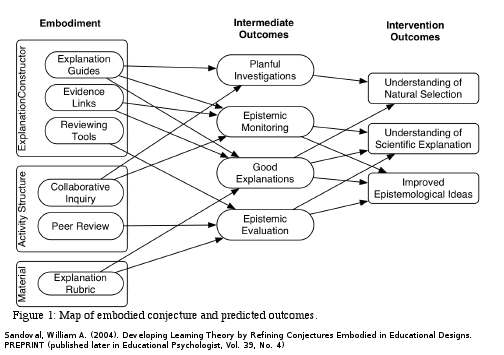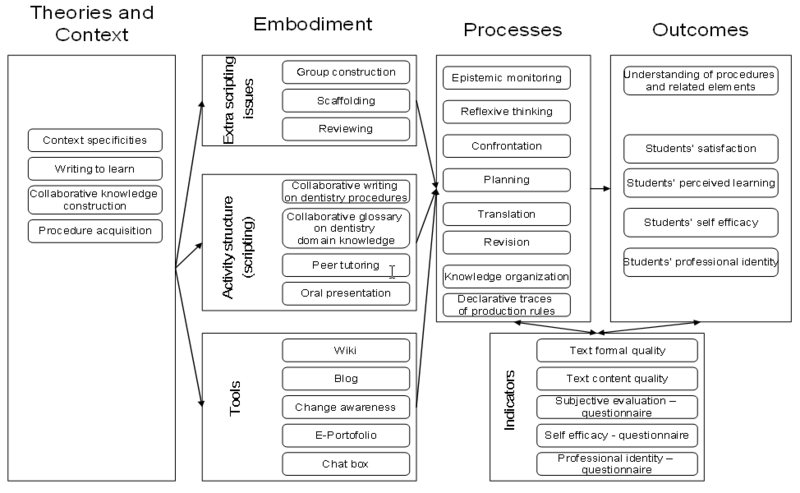Conjecture map: Difference between revisions
m (Created page with 'x Category: Cognitive tools category: Research methodologies Category: Knowledge and idea management Category: Visualization') |
m (using an external editor) |
||
| Line 1: | Line 1: | ||
== Intoruction == | |||
A '''Conjecture map''' is a research planning and organization tool used in [[design-based research]]. | |||
According to Sandoval (2004a:abstract), {{quotation|designed learning environments embody conjectures about learning and instruction, and the empirical study of learning environments allows such conjectures to be refined over time. The construct of embodied conjecture is introduced as a way to demonstrate the theoretical nature of learning environment design, and to frame methodological issues in studying such conjectures.}} | |||
"Design" in this context refers to to interventions, including designed technologies, curricular materials, and participation structures. More precisely, {{quotation |designed learning environments embody design conjectures about how to support learning in a specific context, that are themselves based on theoretical conjectures of how learning occurs in particular domains. Learning theory is often underspecified with respect to learning environment design and the educational research should understand the formulation of appropriate design conjectures as theoretical activity.}} | |||
An '''embodied''' conjecture is a conjecture about how theoretical propositions might be reified within designed environments to support learning. Designed environments include ''' tools''' (like software), '''materials''', and '''activity structures''' (defined as the combination of task structure, how a task is organized, and social participation structures, Erickson, 1982). | |||
Embodied conjectures should predict outcomes at two levels: | |||
* intermediate outcomes are observable patterns of behavior predicted by a model of how an embodied conjecture functions should support learning. | |||
* intervention outcomes, refer to the sort of outcome that psychologists look for, e.g. whether students learn what they are intended to learn. | |||
Embodied conjectures also should predict interactions with their contexts of use. | |||
The idea of a conjecture map is to link design elements to "intermediary variables" to desired outcomes. Each link is a kind of hypothesis for which various kinds of data could provide some support. | |||
; BGUILE example | |||
{{quotation|ExplanationConstructor and related aspects of the BGuILE learning environment were designed by conjecturing that epistemological conceptions influence scientific inquiry to the extent that they frame particular goals for the kinds of knowledge inquiry can generate, while such ideas are practically helpful only to the extent that conceptual knowledge of particular domains can generate possible explanations and investigative strategies. This conjecture led to the design conjecture to integrate conceptual and epistemic scaffolds for inquiry, which was predicted to help students both learn a particular science topic and about scientific epistemology.}} (Sandoval 2004a). | |||
[[image:sandoval-conjecture-map-example.png|frame|none|Example conjecture map by William A. Sandoval]] | |||
It also may be useful to link design elements (embodied conjectures) to general learning and instructional theory. Here is a skeleton to get started: | |||
<table border="1"> | |||
<tr><th>Theoretical conjectures</th> | |||
<th>Embodied conjectures</th> | |||
<th>Intermediate outcomes</th> | |||
<th>Objective outcomes</th> | |||
</tr> | |||
<tr> | |||
<td>General theory <br/> not embodied, not operational</td> | |||
<td>Design elements:<br/>Rather features than<br/>just "names"</td> | |||
<td>What's happening ? <br/>What students <br/>and teachers do</td> | |||
<td>What students <br/> will learn</td> | |||
</tr> | |||
</table> | |||
; DUAL-T conjecture map about learning to write | |||
Below is an example from the [http://dualt.epfl.ch/ DUAL-T] project: | |||
[[image:dualt-writing-to-learn-conjecture-map.png|thumb|800px|none|Conjecture map example for the DUAL-T collaborative writing framework]] | |||
[[User:Daniel K. Schneider|Daniel K. Schneider]] wonders if sometimes one also might a fifth column to separate activity design from tools design. Both together form a cognitive instrument, but to get/configure affordable tools can be research problem by itself. | |||
<table border="1"> | |||
<tr><th>Theoretical conjectures</th> | |||
<th>Embodied conjectures - <br/> activity types</th> | |||
<th>Embodied conjectures - <br/> tools</th> | |||
<th>Intermediate outcomes</th> | |||
<th>Objective outcomes</th> | |||
</tr> | |||
<tr> | |||
<td>General theory <br/> not embodied, not operational</td> | |||
<td>Design elements:<br/>Teacher and learner <br/> activity elements</td> | |||
<td>Design elements:<br/>Tools with features <br/> (e.g. software modules)</td> | |||
<td>What's happening ? <br/>What students <br/>and teachers do</td> | |||
<td>What students <br/> will learn</td> | |||
</tr> | |||
</table> | |||
Alternatives to conjecture maps are tables like the one that is used by Jianwei Zhang et al. (2007:112) and presented in summarized form in the the [[knowledge-building community model]] article. | |||
[[Category: Cognitive tools]] | [[Category: Cognitive tools]] | ||
Revision as of 10:43, 8 January 2010
Intoruction
A Conjecture map is a research planning and organization tool used in design-based research.
According to Sandoval (2004a:abstract), “designed learning environments embody conjectures about learning and instruction, and the empirical study of learning environments allows such conjectures to be refined over time. The construct of embodied conjecture is introduced as a way to demonstrate the theoretical nature of learning environment design, and to frame methodological issues in studying such conjectures.”
"Design" in this context refers to to interventions, including designed technologies, curricular materials, and participation structures. More precisely, “designed learning environments embody design conjectures about how to support learning in a specific context, that are themselves based on theoretical conjectures of how learning occurs in particular domains. Learning theory is often underspecified with respect to learning environment design and the educational research should understand the formulation of appropriate design conjectures as theoretical activity.”
An embodied conjecture is a conjecture about how theoretical propositions might be reified within designed environments to support learning. Designed environments include tools (like software), materials, and activity structures (defined as the combination of task structure, how a task is organized, and social participation structures, Erickson, 1982).
Embodied conjectures should predict outcomes at two levels:
- intermediate outcomes are observable patterns of behavior predicted by a model of how an embodied conjecture functions should support learning.
- intervention outcomes, refer to the sort of outcome that psychologists look for, e.g. whether students learn what they are intended to learn.
Embodied conjectures also should predict interactions with their contexts of use.
The idea of a conjecture map is to link design elements to "intermediary variables" to desired outcomes. Each link is a kind of hypothesis for which various kinds of data could provide some support.
- BGUILE example
“ExplanationConstructor and related aspects of the BGuILE learning environment were designed by conjecturing that epistemological conceptions influence scientific inquiry to the extent that they frame particular goals for the kinds of knowledge inquiry can generate, while such ideas are practically helpful only to the extent that conceptual knowledge of particular domains can generate possible explanations and investigative strategies. This conjecture led to the design conjecture to integrate conceptual and epistemic scaffolds for inquiry, which was predicted to help students both learn a particular science topic and about scientific epistemology.” (Sandoval 2004a).
It also may be useful to link design elements (embodied conjectures) to general learning and instructional theory. Here is a skeleton to get started:
| Theoretical conjectures | Embodied conjectures | Intermediate outcomes | Objective outcomes |
|---|---|---|---|
| General theory not embodied, not operational |
Design elements: Rather features than just "names" |
What's happening ? What students and teachers do |
What students will learn |
- DUAL-T conjecture map about learning to write
Below is an example from the DUAL-T project:
Daniel K. Schneider wonders if sometimes one also might a fifth column to separate activity design from tools design. Both together form a cognitive instrument, but to get/configure affordable tools can be research problem by itself.
| Theoretical conjectures | Embodied conjectures - activity types |
Embodied conjectures - tools |
Intermediate outcomes | Objective outcomes |
|---|---|---|---|---|
| General theory not embodied, not operational |
Design elements: Teacher and learner activity elements |
Design elements: Tools with features (e.g. software modules) |
What's happening ? What students and teachers do |
What students will learn |
Alternatives to conjecture maps are tables like the one that is used by Jianwei Zhang et al. (2007:112) and presented in summarized form in the the knowledge-building community model article.

